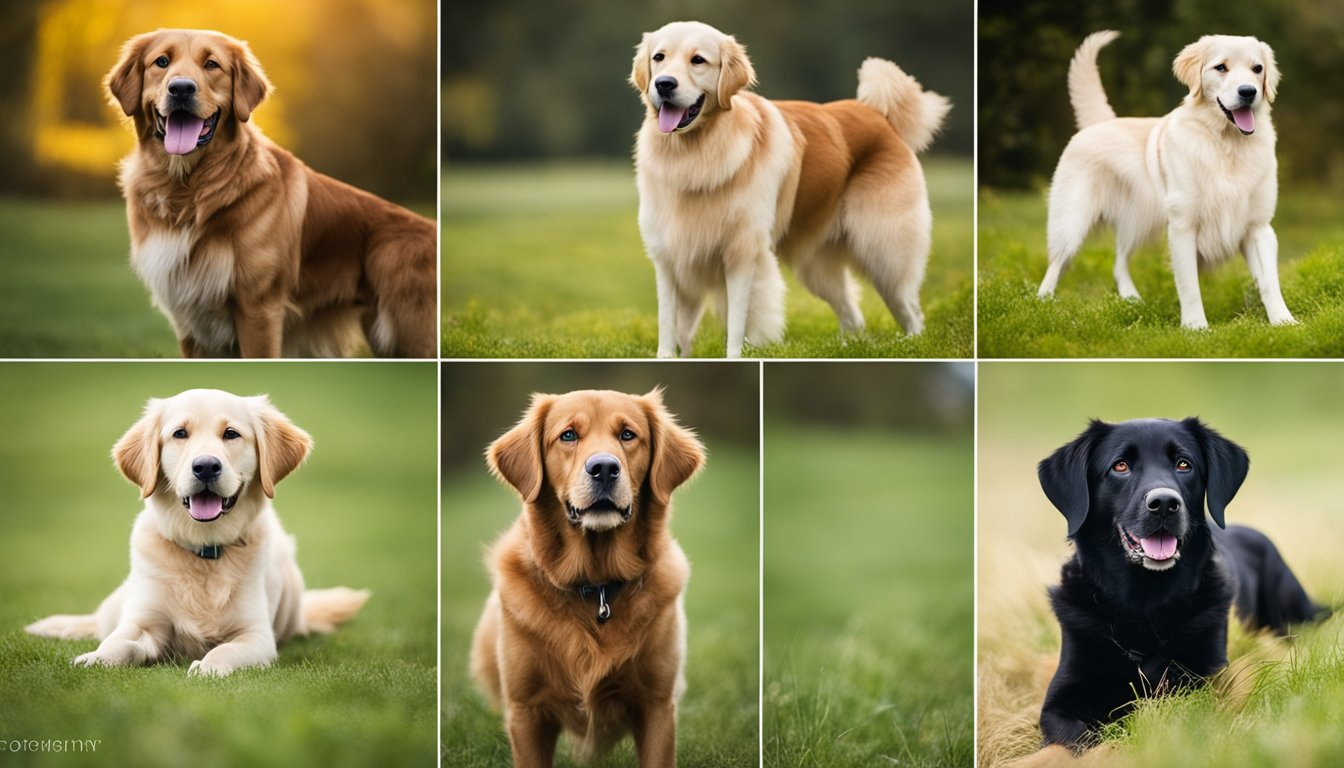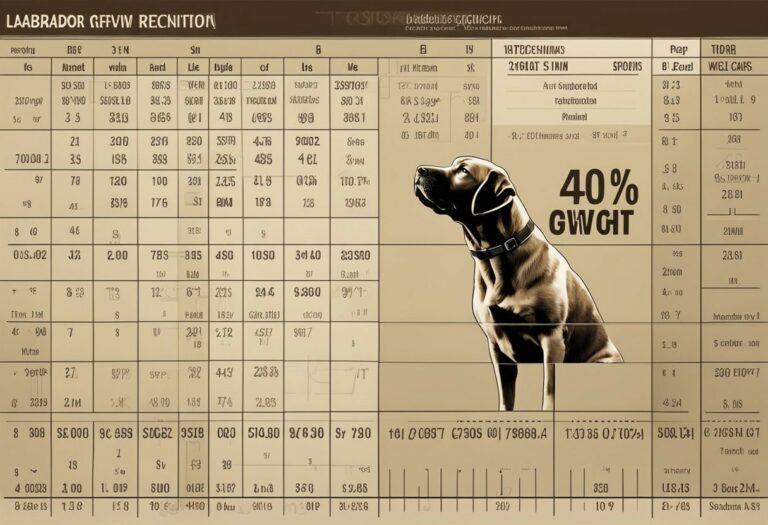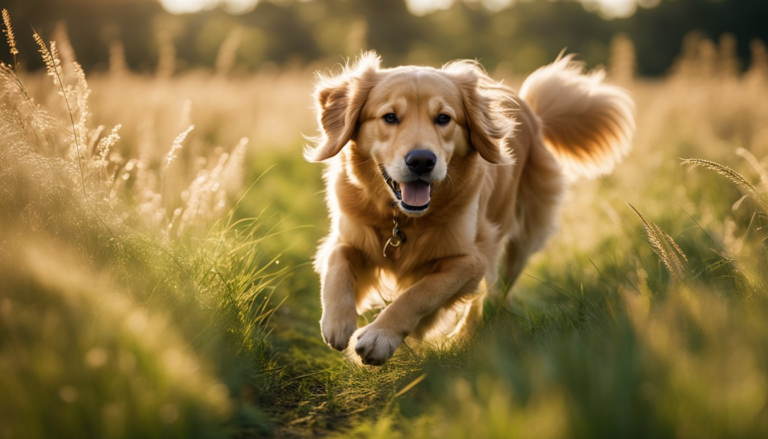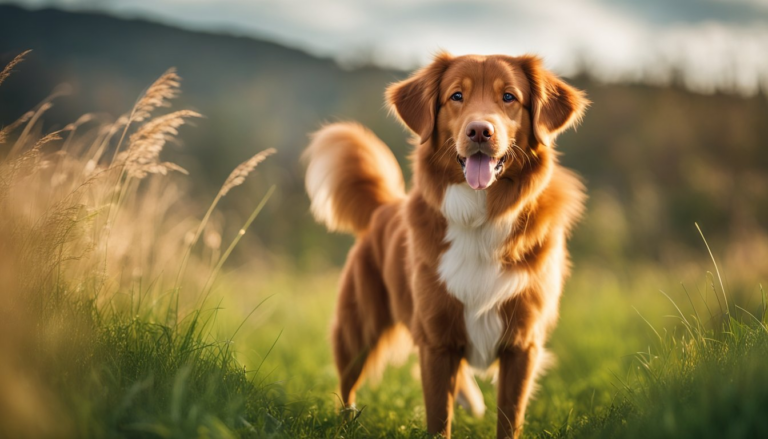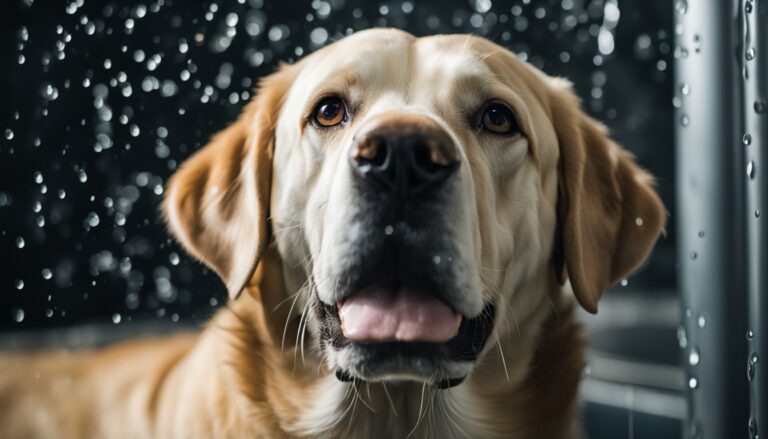Types of Retriever Dog Breeds: A Comprehensive Guide
Retriever dog breeds are known for their friendly and loyal nature, making them popular family pets and working companions. This family of dogs originated from various regions in Europe and North America, where they were traditionally employed as hunting aids for retrieving game, specifically waterfowl. Nowadays, Retriever breeds have diversified into working, show, and companion roles, adapting their natural instincts in numerous domains, including search and rescue, service and therapy, and canine sports.
This article delves into the various types of Retriever breeds, each with distinct features and unique characteristics. You will learn about the Golden Retriever, which is perhaps the most famous Retriever, the Labrador Retriever, the quintessential family pet and service dog, and lesser-known types such as the Flat-Coated Retriever, Chesapeake Bay Retriever, Curly-Coated Retriever, and Nova Scotia Duck Tolling Retriever. You will also explore their roles in work and play, the care and maintenance that each breed requires, and tips on choosing the right Retriever for your lifestyle.
Key Takeaways
- Discover six distinct Retriever breeds, each with a unique set of characteristics and abilities.
- Learn about their roles in various domains, from hunting and service dogs to family pets and canine sports.
- Understand the care and maintenance requirements for different breeds to find the perfect Retriever for your lifestyle.
Overview of Retriever Breeds
| Breed Name | Origin | Average Lifespan | Key Traits |
| Golden Retriever | Scotland | 10-12 years | Friendly, Intelligent, Trainable |
| Labrador Retriever | Newfoundland, Canada | 10-12 years | Loyal, Energetic, Versatile |
| Flat-Coated Retriever | United Kingdom | 10-12 years | Playful, Energetic, Social |
| Chesapeake Bay Retriever | United States | 10-13 years | Independent, Strong-willed, Loyal |
| Curly-Coated Retriever | England | 10-12 years | Dignified, Trainable, Protective |
| Nova Scotia Duck Tolling Retriever | Nova Scotia, Canada | 12-14 years | Energetic, Intelligent, Playful |
Golden Retriever

Origin and History
The Golden Retriever originates from Scotland in the mid-19th century, where it was bred to be a skilled hunting and retrieving dog. The breed’s development was mainly led by Lord Tweedmouth, who crossed a Yellow Retriever with a Tweed Water Spaniel. Over time, other breeds like the Irish Setter, Bloodhound, and St. John’s Water Dog were included in the breeding program, shaping the modern Golden Retriever we know today.
Physical Characteristics
Golden Retrievers are medium-large sized dogs, with males typically weighing 65-75 pounds and females weighing 55-65 pounds. They have a well-proportioned and balanced appearance, with a strong build, muscular body, and a broad head. Their coat is dense, water-repellent, and comes in various shades of gold, ranging from light to dark.
Temperament and Behavior
Golden Retrievers are highly regarded for their friendly, gentle, and intelligent nature. They are known to be excellent family dogs, as they are good with children and form strong bonds with their owners. Their high intelligence, combined with their eagerness to please, make them quite trainable and well-suited for various roles, including assistance, search and rescue, and therapy work.
Common Health Issues
As a breed, Golden Retrievers are predisposed to certain genetic health issues. Some common health concerns include hip and elbow dysplasia, which can lead to arthritis and mobility issues later in life. They are also at risk for various types of cancers, such as hemangiosarcoma and lymphoma.
Other potential health problems include obesity, heart diseases, and eye disorders like progressive retinal atrophy (PRA). Regular vet check-ups and proper care are vital for maintaining a Golden Retriever’s health and ensuring a longer lifespan, generally ranging from 10 to 12 years.
Labrador Retriever

Origin and History
The Labrador Retriever is a popular retriever dog breed with its history dating back to the early 1800s in Newfoundland, Canada. They were bred from St. John’s water dogs, which were then crossed with other breeds such as the English Setter and the Flat-Coated Retriever. The breed evolved over time and was recognized by the AKC breed standard in 1917.
Physical Characteristics
Labrador Retrievers are medium-sized dogs with a strong and well-balanced build. They have a distinctive double coat that is short, dense, and water-resistant, making them excellent swimmers. Their coat colors can range from black, yellow, and chocolate with some having unique markings.
Size and Build:
- Males: 22.5 – 24.5 inches, 65 – 80 pounds
- Females: 21.5 – 23.5 inches, 55 – 70 pounds
Temperament and Behavior
Labrador Retrievers are known for their friendly, intelligent, and gentle nature. They are excellent family dogs, easily interacting with other pets and children. With a soft mouth, they are skilled at carrying objects and retrieving them without damaging them.
Their high intelligence makes them suitable for various roles such as therapy dogs, service dogs, and search-and-rescue dogs. They thrive in an active lifestyle and enjoy playing fetch, swimming, and participating in various dog sports.
Common Health Issues
Labrador Retrievers, like all dog breeds, have some genetic predispositions that can lead to health issues. Some common health problems include:
- Hip and elbow dysplasia: A malformation in the joints that can cause arthritis and joint pain.
- Progressive retinal atrophy (PRA): A genetic eye disorder that can lead to blindness.
- Obesity: Labs are prone to weight gain and require a balanced diet and regular exercise to maintain a healthy weight.
Providing regular check-ups, a balanced diet, and consistent exercise can help manage these health risks and increase their lifespan, which typically ranges from 10 to 12 years.
Flat-Coated Retriever

Origin and History
The Flat-Coated Retriever is a dog breed that originated in the 19th century in the United Kingdom. This breed was developed to be versatile and efficient in retrieving game, both on land and in water. The Flat-Coated Retriever is a result of crossing various breeds, such as the Newfoundland, Labrador Retriever, and various water spaniels.
Physical Characteristics
Flat-Coated Retrievers are medium to large-sized dogs, with a strong and athletic build. They have a unique, dense, and waterproof coat that comes in two colors: solid black and solid liver. Their coat is designed to protect them from harsh weather conditions and cold water, making them excellent swimmers.
The breed’s head is long and well-defined, while their ears are set moderately close to the skull and hang down. The tail of a Flat-Coated Retriever is commonly referred to as the “racy” tail because of its slightly curved and tapered appearance.
Temperament and Behavior
Flat-Coated Retrievers are known for their friendly, intelligent, and gentle nature. They are excellent family dogs, as they tend to get along well with children and other pets. They possess a strong desire to please their owners, which makes them highly trainable and eager to learn.
Due to their retriever instincts, they have a soft mouth, enabling them to carry game without damaging it. Flat-Coated Retrievers are also energetic and require regular exercise to maintain their physical and mental health.
Common Health Issues
Like many other breeds, Flat-Coated Retrievers are prone to certain genetic predispositions. One of the most prevalent health concerns in this breed is histiocytic sarcoma, a rare and aggressive form of cancer. Their lifespan ranges from 10 to 12 years, and maintaining their health involves regular check-ups, a balanced diet, and consistent exercise.
By monitoring and managing their health, owners can help ensure that their Flat-Coated Retrievers lead long, happy lives as cherished members of the family.
Chesapeake Bay Retriever

Origin and History
The Chesapeake Bay Retriever has its origins in the United States, specifically in the Chesapeake Bay region. This breed is the result of early breeding and development between various retrievers, including Newfoundlands and other local water dogs. The American Kennel Club (AKC) officially recognized the Chesapeake Bay Retriever in 1918, making it one of the oldest retriever breeds in the nation.
Physical Characteristics
This medium to large-sized dog breed has a distinct double coat, consisting of a dense undercoat and a wavy, waterproof outer coat. Coat colors typically range from dark brown to light deadgrass, with occasional white markings on the chest. Chesapeakes have a strong build, making them adept at swimming and retrieving in various weather conditions.
Size and Build:
- Male: 65-80 lbs (29-36 kg), 23-26 inches (58-66 cm) at the shoulder
- Female: 55-70 lbs (25-32 kg), 21-24 inches (53-61 cm) at the shoulder
Temperament and Behavior
Chesapeake Bay Retrievers are known to be intelligent, friendly, and gentle dogs. They are strong-willed and may require persistent training, but reward their owners with unwavering loyalty. In addition to being excellent family dogs, they get along well with other pets and have a natural affinity for water and outdoor activities.
Common Health Issues
As with many dog breeds, Chesapeake Bay Retrievers can be predisposed to certain genetic health issues. Among these are hip dysplasia, progressive retinal atrophy (PRA), and a skin condition called ectodermal dysplasia-skin fragility syndrome specifically found in some Chesapeake Bay Retrievers. It’s necessary to consult with a veterinarian for regular check-ups and preventive care. The average lifespan for a healthy Chesapeake Bay Retriever is 10-13 years.
Curly-Coated Retriever

Origin and History
The Curly-Coated Retriever is an old and distinct retriever breed, originally developed in England in the 18th century. They were bred as gun dogs, with a primary purpose to retrieve birds during hunting activities. Their ancestry is believed to include English Water Spaniels, Irish Water Spaniels, and the St. John’s Newfoundland dog.
The breed gained recognition from the American Kennel Club (AKC) in 1924, and has since become popular as both a working dog and a family companion.
Physical Characteristics
The Curly-Coated Retriever has a unique appearance, characterized by tight curls covering its entire body, except for its face and legs. Their coat is typically solid black or liver-colored, with no other markings or colors. The breed has a strong, muscular build, with a deep chest and a well-balanced physique.
They display a soft mouth, which enables them to pick up and carry birds without damaging them. Males usually stand 25-27 inches tall, while females range from 23-25 inches. Adult Curly-Coated Retrievers generally weigh between 70 and 95 pounds.
Temperament and Behavior
Curly-Coated Retrievers are known for their friendly, intelligent, and gentle nature. They have a strong work ethic and a natural ability to retrieve on both land and water. Early socialization and training are essential for this breed, as it helps to develop their amiable personality and ensures positive interactions with families, other pets, and strangers.
Curly-Coated Retrievers enjoy spending time with their human family and tend to be protective without being aggressive. They require regular mental and physical stimulation to keep them happy and healthy. Their energy and athleticism make them excellent candidates for activities such as agility, obedience, and field trials.
Common Health Issues
Curly-Coated Retrievers are generally a healthy breed, with a typical lifespan of 10-12 years. However, like all dog breeds, they can be predisposed to certain health issues. Some common conditions seen in this breed include hip dysplasia, progressive retinal atrophy (PRA), and glycogen storage disease type IIIa.
Responsible breeding practices and regular veterinary care can help to reduce the occurrence of these problems, ensuring a long and happy life for the Curly-Coated Retriever.
Nova Scotia Duck Tolling Retriever

Origin and History
The Nova Scotia Duck Tolling Retriever (NSDTR) is a medium-sized retriever breed originating from the province of Nova Scotia in Canada. This breed, commonly known as “Tollers,” was developed in the early 19th century to lure waterfowl within shooting range using their unique tail-wagging technique. Through early breeding and development, the Toller evolved over time to become a skilled and efficient retriever.
Physical Characteristics
The Nova Scotia Duck Tolling Retriever has a compact and athletic build, with a medium-to-long double coat that is water-repellent and comes in various shades of red and orange. They typically have distinctive white markings on their face, chest, and paws. Their size ranges from 17 to 21 inches in height at the shoulders, and they weigh between 35 and 50 pounds.
Temperament and Behavior
Tollers are known for their friendly, intelligent, and gentle nature, making them excellent family dogs. They are highly social and generally get along well with other pets. They have a strong work ethic and enjoy being active, participating in activities such as obedience, agility, and field trials.
The breed is particularly suited for families with an active lifestyle, as they require regular physical and mental stimulation to thrive.
Common Health Issues
While the Nova Scotia Duck Tolling Retriever is generally a healthy breed, they can be predisposed to certain health problems, like many other dog breeds. Some common health issues found in the breed include hypoadrenocorticism, degenerative disc disease, and cerebellar degeneration. Responsible breeding practices and regular health check-ups can help manage these potential issues and contribute to a longer lifespan for the Toller, which typically ranges from 12 to 14 years.
Retrievers in Work and Play
Hunting Companions
Retrievers have a long history as hunting companions for hunters seeking birds and small game. These breeds were specifically developed to assist in retrieving shot game, earning them a spot in the sporting group of gun dogs. In the early days of retriever development, they were primarily used for retrieving game during waterfowl hunting, but they have since expanded their hunting capabilities.
Retrievers possess a natural aptitude for locating downed birds and retrieving them to their handlers, thanks to their excellent sense of smell and soft mouths. Some popular retriever breeds include the Labrador Retriever, Golden Retriever, and Chesapeake Bay Retriever. Training is essential when it comes to honing their hunting skills and ensuring success in the field.
Dog Sports and Competitions
Retriever breeds excel in various dog sports and competitions, showcasing their agility, obedience, and intelligence. Popular sports for Retrievers include:
- Field Trials: Retrievers participate in field trials to demonstrate their hunting and retrieving skills. They must locate and retrieve simulated game, often under challenging conditions.
- Obedience Trials: Obedience trials showcase a dog’s ability to follow commands and perform specific tasks, often requiring precision and focus.
- Agility Competitions: In these events, dogs navigate an obstacle course at a fast pace, relying on their agility, speed, and coordination.
Retriever breeds often achieve notable accomplishments in these competitions, setting records and earning titles based on their performance.
Service and Therapy Roles
Retrievers have proven to be incredibly versatile, taking on roles as service and therapy dogs. Their intelligence, eagerness to please, and gentle temperament make them an ideal fit for these important tasks. Some of the roles retrievers fulfill include:
- Guide Dogs: Labrador Retrievers, in particular, are frequently used as guide dogs for the visually impaired, providing assistance and enabling their handlers to navigate their surroundings safely.
- Disability Assistance Dogs: Retrievers can be trained to assist individuals with various disabilities, assisting with tasks like opening doors, fetching items, and providing physical support.
- Emotional Support and Therapy Roles: These breeds are often used as emotional support animals or in therapy settings, where they provide comfort and companionship to those in need.
Retrievers have come a long way from their hunting origins and have established themselves as valuable companions in various aspects of human life, from sports and competitions to vital service and therapy roles. Their adaptability and dedication to their handlers make them a beloved and respected addition to many families and communities.
Care and Maintenance
Grooming Needs
Caring for a retriever’s coat has a pivotal role to maintain their health and appearance. Retrievers come in various coat types, such as curly, double coat, or a simple flat coat. To maintain their coat, different grooming tools and techniques should be employed. For example, a specific brush is available for double coats to help remove dead hair and prevent shedding.
Regular grooming also gives owners the chance to check for ticks, fleas, and any skin abnormalities. It’s necessary to remember that coat care for different retrievers may vary; so researching the specific breed’s needs is essential.
Exercise Requirements
Retrievers are high energy breeds that require regular exercise to stay healthy and happy. Different breeds may require varying daily activity levels. Ensuring your retriever gets a proper amount of exercise helps prevent undesirable behaviors that stem from pent-up energy.
Owners can engage their retrievers in suitable games and exercises such as:
- Fetch
- Swimming
- Hiking
- Agility courses
- Long walks
These activities provide mental and physical stimulation, which is essential for a well-rounded and content retriever.
Training and Socialization
Retrievers are known for their excellent trainability and eagerness to learn. They respond well to positive reinforcement and reward-based training. Puppy training classes can be beneficial in setting the foundation for obedience, socialization, and addressing common behavioral issues.
Socializing your retriever is equally important as training. Expose the dog to various environments, people, and other animals to develop their confidence and ability to adapt. A well-socialized retriever is less likely to exhibit fear or aggression towards unfamiliar situations.
Remember, retriever breeds have unique needs when it comes to care and maintenance, so taking the time to research and understand their requirements will benefit both the dog and the owner.
Choosing the Right Retriever for You
Factors to Consider
When choosing the right retriever for you, it is essential to assess your family and living situation. Each of the six different types of retrievers has a unique temperament and personality, but all retrievers are generally friendly, intelligent, and gentle. They make excellent family dogs and get along well with children. However, to ensure a good match for both the dog and your family, consider these factors:
- Living space: Retrievers vary in size, and some require more room to move around comfortably. Make sure your home and outdoor space are adequate for the breed you are considering.
- Activity levels and time commitment: All retrievers are energetic and require regular exercise to stay healthy and happy. Evaluate whether you can commit to providing the necessary physical activity and mental stimulation for your desired breed.
Temperament Matching
Understanding the breed-specific temperaments of retrievers will help you find a dog that meshes well with your individual and family personalities. Here are some key characteristics of each retriever breed to consider:
- Golden Retriever: This breed is the epitome of a family dog. Goldens are friendly, outgoing, and highly adaptable, making them a great choice for families with children or other pets.
- Labrador Retriever: Labradors are high-energy, loyal, and intelligent. They require plenty of exercise and mental stimulation, so they’re a great fit for active families or those involved in dog sports.
- Chesapeake Bay Retriever: Known for their independence and strong work ethic, this breed can be somewhat reserved with strangers. Chesapeakes are best suited for experienced dog owners willing to invest time in training and socialization.
- Flat-Coated Retriever: These cheerful, playful dogs are always eager to please and make friends with everyone they meet. They thrive in households that can provide them with ample human interaction and physical activity.
- Curly-Coated Retriever: Curly-Coats possess an air of dignity but are also friendly and trainable. They tend to prefer being the only pet in the household but get along well with older children and adults.
- Nova Scotia Duck Tolling Retriever: The smallest of the retriever breeds, these intelligent and energetic dogs require lots of mental stimulation. They’re an excellent choice for families who enjoy outdoor activities and adventures.
Visual Gallery
High-quality images of each Retriever breed
A visual gallery of retriever breeds can provide a clear understanding of their physical characteristics, helping potential dog owners to choose the perfect companion. High-quality images that capture the unique features of each breed can be a valuable resource. For example, showcasing the difference in coat types, colors, and sizes between the Golden Retriever and the Labrador Retriever can aid in decision-making.
Besides the popular Golden and Labrador Retrievers, the gallery may also include images of the Chesapeake Bay Retriever, Flat-coated Retriever, Curly-coated Retriever, and the Nova Scotia Duck Tolling Retriever. A visual representation of these breeds will help emphasize distinctive traits such as the curly coat of the Curly-coated Retriever, the unique feathering on the Flat-coated Retriever’s tail, or the fox-like appearance of the Nova Scotia Duck Tolling Retriever.
Captions detailing breed specifics
In addition to high-quality images, it is essential to include informative captions for each retriever breed. Captions can provide brief but useful insight into the breed’s history, temperament, and abilities.
For example:
- Golden Retriever: Originating in Scotland in the late 1800s, Goldens are friendly, intelligent, and devoted companions. They excel in various dog sports, such as agility, obedience, and tracking, as well as being excellent therapy and assistance dogs.
- Labrador Retriever: The most popular dog breed in the United States, Labradors were initially bred for retrieving game in Newfoundland. They are known for their loyalty, gentle nature, and adaptability to various roles, ranging from search and rescue to working as guide dogs for people with disabilities.
- Chesapeake Bay Retriever: Developed in the United States, this breed is known for its endurance, strength, and love of water. Their versatility makes them excellent hunting companions and family pets.
- Flat-coated Retriever: With an upbeat personality and a passion for retrieving, Flat-coats are versatile working dogs. Their cheerful demeanor and strong work ethic make them a joy to train and live with.
- Curly-coated Retriever: As one of the oldest retrieving breeds, they are known for their distinctive curly coat and exceptional swimming abilities. They are often independent thinkers, making them both challenging and rewarding to train.
- Nova Scotia Duck Tolling Retriever: Hailing from Canada, these energetic, intelligent dogs were bred to lure and retrieve waterfowl. Their playful and alert nature makes them excellent family pets and agile competitors in dog sports.
By combining high-quality images with informative captions, the visual gallery will provide an engaging and useful resource for those interested in learning more about retriever breeds.
Frequently Asked Questions
What are the differences between red and white retrievers?
Red retrievers have a darker coat color ranging from dark gold to a deep red shade. White retrievers, on the other hand, have a pale cream or white coat color. Both types belong to the same retriever breeds like Labrador and Golden Retrievers; however, the difference lies mainly in their coat color.
Which small retriever breeds make good pets?
While retrievers are generally medium to large-sized dogs, some smaller breeds with retriever characteristics make excellent pets. Nova Scotia Duck Tolling Retrievers, also known as “Tollers,” are a popular small retriever breed known for their intelligence and versatility.
Are there any distinctive characteristics of black retrievers?
Black retrievers, especially black Labrador Retrievers, are known for their dense, weather-resistant coats, and friendly demeanor. They have the same general characteristics, temperament, and behavior as their counterparts in other colors, making them excellent companions, working dogs, and service animals.
How do Golden Retriever puppies differ from other retriever breeds?
Golden Retriever puppies are known for their friendly and playful personalities. While other retriever breeds may show some overlap in temperament, Golden Retrievers tend to be more affectionate with humans and may exhibit lower aggression levels.
What factors affect the price of a retriever dog?
The price of a retriever dog depends on various factors such as the breed, pedigree, coat color, and the breeder’s reputation. Additionally, factors such as demand, supply, and location can influence the price. It is essential to research and choose a responsible breeder to ensure a healthy and well-adjusted puppy.
What makes a retriever mix unique compared to purebred retrievers?
Retriever mixes inherit traits from both parent breeds, which may result in unique physical appearances and temperaments. Some individuals may prefer retriever mixes as they can potentially possess the desirable characteristics of both breeds involved, while potentially having fewer health concerns often associated with purebred dogs.

